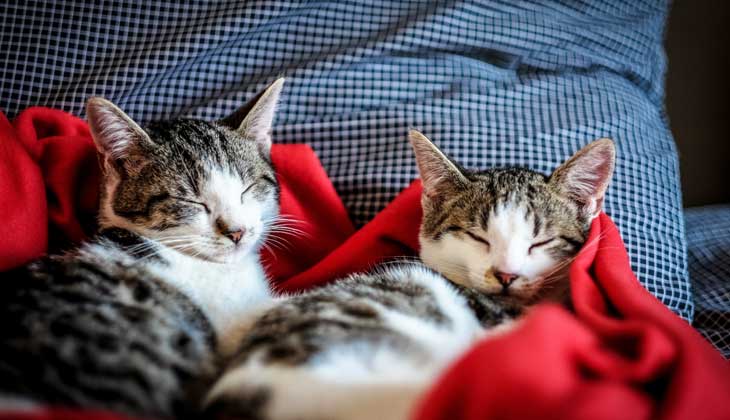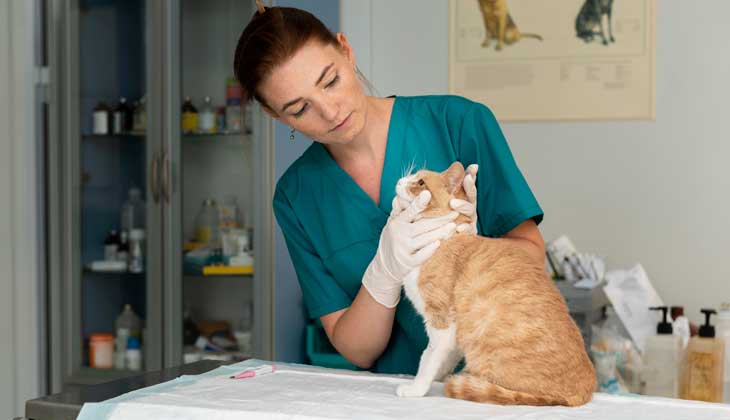What You Should Know About Feline Leukemia Virus
HEALTH & PROTECTION
29 Jun, 2022
6 minutes

Feline leukemia virus (or FeLV) is an important cause of severe and often fatal disease in cats. Like all viruses, FeLV is a tiny microorganism that can only replicate inside living cells. Based on the name, you might think that FeLV only causes blood cancer, like leukemia in humans. Although the virus can indeed cause leukemia, it can also cause other cancers and also suppress the immune system leading to an increased susceptibility to many other infections.
Many cats are at risk of becoming infected with FeLV. This includes many young cats and kittens, cats that go outdoors, and cats that live in households with other cats that might carry the virus. Eighty-five percent of persistently infected felines commonly die within three years of diagnosis.
Yet, exposure to FeLV does not have to be a death sentence – cats with a strong immunity that are exposed to the virus are largely able to resist infection and control/eliminate it on their own.
How do Cats become infected with FeLV?
FeLV is transmitted to healthy cats during close contact with infected cats because the virus is found in saliva, nasal secretions, urine, faeces, and blood. Mutual grooming or bite wounds tend to be the primary way cats become infected however something as simple as shared food or water dishes can also be sources of infection. Kittens can get the virus from infected mothers while still in the womb or through nursing.
Once the virus has infected a cat, it multiplies and enters the blood. Depending on how effective a cat’s immune system is in fighting the virus, the infection can take several courses. In some cats, the virus is successfully fought off. In others, it hides in body tissues but does not cause immediate signs of disease. In yet other cats, it spreads throughout the body and causes serious illness.


What are the signs of FeLV infection?
Many cats will have no signs of illness initially, but their health will gradually become worse over weeks, months, or even years. Many cats show a large variety of signs that are not very specific, including poor coat condition, skin and respiratory infections, eye problems, weakness, in addition to a host of other issues.
Common signs include:
- Fever
- Loss of appetite
- Weight loss
- Diarrhoea
- Swollen lymph nodes
- Pale or inflamed gums
How is FeLV Diagnosed?
Your veterinarian can determine if a cat is infected with FeLV by performing a simple blood test that identifies FeLV proteins in the blood. These tests are both sensitive and specific and can identify cats with very early infections but because many cats show no signs of disease even if they are infected, it is important for all untested cats in a household to be tested.
Who should be tested for FeLV?
It is advised that all of the following cats in the household be tested for FeLV:
- All cats at least once
- All new litters of kittens
- Any new cat brought into a household
- Sick cats
- Cats with signs of FeLV-associated disorders, such as cancer, anaemia, and immune disease
- Cats with high-risk lifestyles (e.g. cats that come into contact with cats outside the household)
- Unvaccinated cats before being vaccinated against FeLV

Is my cat at risk for infection?
Exposure to infected cats will raise your cat’s risk of contracting FeLV. This is especially true for kittens and young adult cats. If your cat goes outside, fights with other cats, lives in a household where he or she is frequently exposed to new cats, or has close contact with other cats, you should speak to your veterinarian about preventative measures you can take to protect your cat, such as vaccination.
Despite transmission rates of FeLV, the prevalence of the disease has actually decreased over the last 25 years because of effective vaccines and reliable tests. While this is positive news, the risk of infection is still a real threat in many regions throughout many countries, and it is therefore still important to test and vaccinate as advised by your veterinarian who will be familiar with the local risk of infection.
What can be done if my cat becomes infected?
Good care can help keep your cat feeling well for a long time. A nutritious diet is very important. Also, cats should be kept indoors and be spayed or neutered to protect them from exposure to other diseases and reduce stress. Twice-yearly veterinary visits will help ensure FeLV-infected cats get the care they need.
Cats with persistent FeLV infection may live several years, but their overall life expectancy is decreased compared with uninfected cats. About eighty percent of cats with active FeLV infection die within three years of diagnosis.
Since persistently-infected cats can readily transmit infection to other cats they should be kept away from contact with other cats – especially young kittens and any unvaccinated cats.
How can I protect my cat from FeLV infection?
Keeping your cat indoors and away from other cats that might be infected with FeLV is one way to help protect your cat from contracting an infection. However, this may be impractical and for cats that go outdoors and may come into contact with other cats, effective FeLV vaccines are available. Your veterinarian can help determine whether your cat should be vaccinated against FeLV. Ask your vet about Nobivac® HCP+FeLV.
Is vaccination against FeLV safe?
Cats have been getting successfully vaccinated against FeLV for many years and while minor side effects do occur, the vaccines are generally safe and well-tolerated. Sometimes cats will experience mild side effects such as tenderness or swelling at the injection site, listlessness, or fever, but these generally go away very quickly. Ultimately, the benefits of protecting your cat against the serious, deadly disease associated with FeLV infection usually outweigh the risks of potential side effects from vaccination. Today some vaccines only require boosting every two years instead of annually, meaning that it is easier than ever to maintain your cat’s protection against FeLV.
There is no cure for FeLV infection. REDUCING THE RISK OF EXPOSURE and ENSURING ANY AT-RISK CATS ARE VACCINATED are the best ways to manage it.
ZA-NON-220400010








